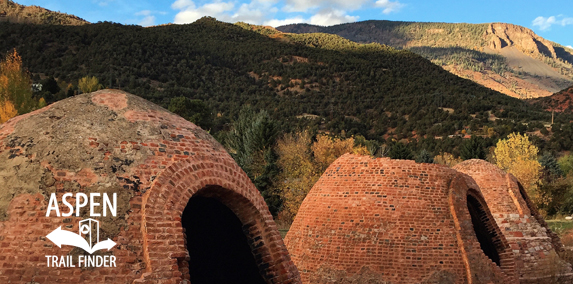Connects: Basalt Historical Walking Tour, Arbaney Park, Arbaney Barn, Arbaney Residence

The historic charcoal kilns in Arbaney Park
Basalt, CO – Coke Ovens
The Frying Pan Coke Ovens, or Fryingpan Kilns, are seven kilns that were built in 1884 by the Aspen Silver Company due to demand from the Aspen smelters for refining charcoal. This a historic site along the Basalt Historical Walking Tour in Basalt, CO.
More information about the Frying Pan Coke Ovens can be found at:
Basalt Regional Heritage Society – Basalt Historical Walking Tour
Wikipedia – Coke (fuel)
The construction of the kilns dates back to the early 1880s, the beginning of great change and dynamic growth in the Roaring Fork, Fryingpan and neighboring river valleys. In 1880, Aspen’s population employed in the silver mining industry was 900. The mining produced raw ore which required initial smelting before being shipped for refinement. Demand from the Aspen smelters for refining charcoal, which burned hotter than wood, resulted in the construction of seven kilns by the Aspen Silver Company in 1884. The availability of fuel from the vast stands of pine and pinion trees was the prime reason for the selection of the site.
The kilns were constructed of unfired brick and native stone. They appear to have been constructed with an outside coating of standard mortar for protection from the elements. The kilns have upper and lower openings, typical for this type of processing. The openings were used for ventilation and for the addition of fuel and the removal of the charcoal produced.
A settlement of tents and shacks grew around the kilns. The little community was called Fryingpan, and the community at one time included several tent saloons and a tent store. Horses and mules were used at that time to haul the charcoal produced up to Aspen. A halfway house for the stage lines was also built during this period, which you will see at the next stop. The kilns and halfway house are the only remnants of this early community. With the coming of the Colorado Midland Railroad in 1887, the Town of Aspen Junction was formed across the Frying Pan River from the kilns. Most of the residents of Fryingpan soon relocated there. The discovery of coal near Carbondale and the arrival of the railroad allowed the smelters in Aspen to utilize coke from ovens in Cardiff (near Glenwood Springs) and the Crystal River Valley. The Frying Pan kilns ceased to operate in 1887.
The kilns were used as equipment and grain storage for the ranching operations of various families. You can see in one kiln where a doorway was squared off and framed; the foundations of wood dividers are still visible on the floor, which separated oats and wheat.
As Basalt started to grow and subdivisions sprouted on the former ranches, the town purchased the kiln property as part of Arbaney Park. The kilns were in public hands, but not protected. Over the years, weathering and vandalism took a toll. In 2007 a group of concerned citizens formed to protect the kilns, and in 2010 the restoration work was completed.”



 (7 votes, avg: 8.86 out of 10)
(7 votes, avg: 8.86 out of 10)




















